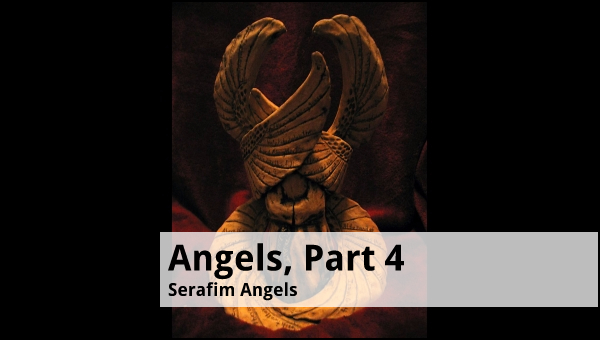By Tyson Thorne

Last week we started our series on angels, learning about their origins and basic nature. We then looked at three classes of angels, the militant arm lead by the Archangel Michael, Cherubim who act as guards and Ophanim who backup the Cherubim in their service and transport the royal chariot. Today we learn about the only other named group of angels, the Seraphim. They are mentioned only once in all of Scripture, in Isaiah chapter six, and their description is minimal. They are described as having hands, feet and six wings. Most scholars assume they have a human form, but this isn’t necessarily the case.
The word “Seraphim” comes from the Hebrew word “seraph”, which literally means “fiery”. It is used of the poisonous snakes that invaded the Israelite camp shortly after their exodus from Egypt. A bronze image of the serpents was fashioned on Moses staff offering life to all who were bitten if only the afflicted would look to it. This reference has caused to think that perhaps the Seraphim had the form of a serpent rather than a human. Since they have arms and legs they would have resembled the serpent of the garden rather than modern day snakes. This is also how they are represented in the Book of Enoch, a non-Biblical text of ancient Jewish origin.
From what little we can learn from Isaiah, Seraphim reside in the throne room. Just as human kings have attendants, so too does the heavenly King and this angelic group fulfill that role. They also praise God. In his vision, a Seraphim cleanses Isaiah’s lips with a burning coal, but it is unknown if “cleansing” is a normal part of their duties. And this all the information we have from the Bible about this remarkable race of angels.
According to Jewish tradition (The Book of Tobit in particular), there is ample evidence the Seraphim do not belong to the same category as angels. In Scripture and other religious books they have nothing to do with the "messengers of God" and are always left out of the lists of angels and "chief" angels. In Christian tradition we have a tendency of classifying all spiritual beings that are not God as angels, either holy or fallen. This works in general but may not be true in the specifics. Since there are a great many types of life forms on the earth, it stands to reason that heaven may be similar. Either way, such distinctions are unimportant to Christian living, though make for an interesting discussion.
Aside from the classes of angels mentioned in the Bible, there are unidentified angelic beings with specific responsibilities. For example, there are the seven angels over the seven churches mentioned in Revelation. Later in John’s prophecy there are angels that pronounce judgments and blow trumpets. There is one (Revelation 14) who has power over fire, another of water (Revelation 9) and a guard of the abyss (Revelation 20).
This is our understanding of angels from a human perspective. It is helpful to understand them in relation to God. As Charles Ryrie points out in his excellent “Basic Theology” an angel’s primary ministry is to worship and praise God:
- Angels praise God (Psalms 148.1-2; Isaiah 6.3)
- Angels worship God (Hebrews 1.6; Revelation 5.8-13)
- Angels rejoice in what God does (Job 38.6-7)
- Angels serve God (Psalms 103.20; Revelation 22.9)
- Angels appear before God for accountability (Job 1.6 and 2.1)
- Angels are instruments of God’s judgments (Revelation 7.1 and 8.2)
|
|
